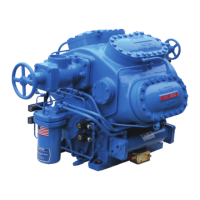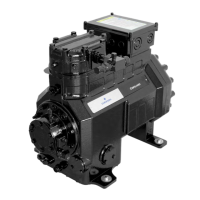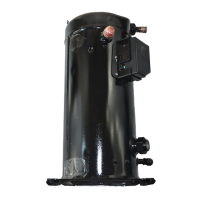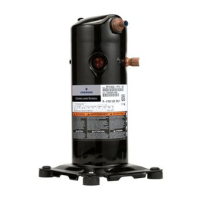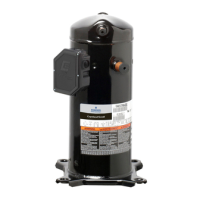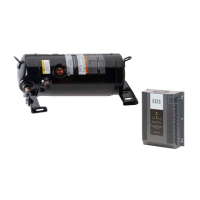2 – 2
VSS/VSR/VSM/VSH/VSSH Compressor • Installation, Operation and Service Manual • Emerson • 35391S
Section 2 • Theory of Operation
The capacity slide provides the means for controlling
specic process set points. By continuously adjusting
the ow of gas through the compressor, either suction
or discharge pressure in a particular process can be con-
trolled. When coupled with a microprocessor controller,
the adjustable capacity slide allows for precise and con-
tinuous automatic control of any parameter in the pro-
cess to a chosen set point.
The second slide for each gate rotor is the volume ratio
slide. The purpose of the volume ratio slide is to maxi-
mize the efciency of the compressor by matching the
gas pressure within the screw ute at the point of dis-
charge to the downstream process requirements. The
volume ratio slide operates at the discharge end of the
screw, and acts to vary the position of the discharge
port. When the slide is extended fully to the discharge
end of the screw (the 100% position), the compression
process within the screw ute continues until the screw
rotates far enough for the ute to pass the end of the
volume ratio slide. At this point, the screw ute lines up
with the discharge port and the compressed gas is ex-
pelled from the screw ute. As the volume ratio slide is
pulled back away from the discharge end of the screw,
the position of the discharge port is changed and the gas
is allowed to escape the screw ute earlier in the com-
pression process, at a reduced pressure.
The overall volume ratio within the compressor is de-
termined by the distance between the front of the ca-
pacity slide (the start of compression) and the back of
the volume ratio slide (the completion of compres-
sion). Therefore, the volume ratio slide must respond to
changes in the downstream pressure measured in the oil
separator and position itself for the required compres-
sion ratio based on the position of the capacity slide.
By only compressing the gas within the screw as far as
required to match the pressure in the downstream re-
ceiver, the compressor efciency is maximized. Proper
positioning of the volume ratio slide prevents either over
compressing or under compressing of the gas within the
screw ute. This allows the single screw compressor to
efciently handle a range of volume ratios from as low
as 1.2 up to 7.0.
Refrigerant and Oil System
The refrigeration and oil systems work in unison, but
each one will be explained separately. Reference Figure
2-1 for refrigerant and oil ow descriptions. This is a typi-
cal refrigeration system with thermosyphon oil cooling.
Refrigerant Flow
The refrigeration compression process begins as refrig-
erant vapor enters the suction inlet (12). The refrigerant
vapor ows through a suction stop/check valve (11),
then through a mesh strainer (10) to the compres-
sor (9). The refrigerant is then pressurized through the
compressor and discharged as high pressure refrigerant
vapor into the oil separator (1). In the oil separator, the
oil is then separated from the discharged refrigerant by
impingement separation. The high pressure refrigerant
ows out to the condenser for cooling while the oil is
pumped or siphoned back to the compressor.
The suction stop/check valve (11) is necessary to prevent
reverse rotation and potential damage or oil loss at shut
down. The discharge check valve (2) is positioned to pre-
vent the vapor or liquid refrigerant from owing back to
the separator when the compressor is shut down.
The separator should be allowed to equalize slowly to
suction pressure through a small bypass line around the
suction stop/check valve (11). This will allow the com-
pressor to start without a pressure differential across it,
reducing the starting power requirements.
Oil Life and Oil Flow
Oil in the refrigeration system serves three primary pur-
poses. They are compressor lubrication, sealing clear-
ances between moving parts, and heat removal result-
ing from heat of compression and friction.
Initially, oil ow is driven by a mechanical gear pump (3).
The oil internally lubricates all points inside the compres-
sor. Once the system reaches design conditions, the oil
pump can be shut off and oil ow is maintained by dif-
ferential pressure. But on units with low pressure differ-
entials such as booster and low pressure differential high
stage compressors, the oil pump must remain on when-
ever the unit is running to maintain sufcient oil ow.
As the oil is separated from the refrigerant in the oil sep-
arator (1), it is pumped or siphoned through an oil cooler
(5), then through an oil lter (4) and back to the injec-
tion port (6) of the compressor (9).
Furthermore, to collect oil from the coalescing side of the
oil separator (1), an oil return line (8) is installed between
the oil separator and the compressor (9). By opening the
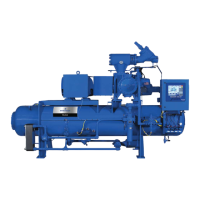
